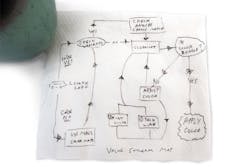“This really hits our heart. I think it’s a must.”
That’s how Jim Siegfied, owner of Crystal Lake Automotive in Lakeville, Minn., describes the shop’s commitment to using the communication tool of mapping as part of the collision repair process. Mapping involves using abbreviations and notations to circle damage and communicate the parts of the vehicle that do or do not need to be repaired. While it is an effective tool, if it becomes too complicated and difficult to understand, it will immediately become ineffective.
Siegfried credits his son, Michael, collision shop manager and owner, with taking the reins to get mapping implemented at the shop in 2012 with a succinct mapping glossary that has not changed much since it began.
Jim and Michael spent some time with FenderBender to take a look at life at the shop since it turned to mapping.
A Benefit for Technicians
A thorough mapping process is imperative, Michael says, as it leads to technicians having fewer questions, which leads to fewer start-stops on cars. In other words, Jim says, mapping “gets everyone on the same page.”
A mapping key pinpoints a dozen common actions that need to be taken, from Repair, denoted with an “R” to Refinish (“P”) to Replace (“X”) and more. See the accompanying mapping key used by Crystal Lake Automotive for more actions.
Jim knows the importance of that consistency from past experience, namely when his shop simply used a “curb sheet” that provided a list of repairs, but also left many questions unanswered.
“The car would get disassembled by the technician, really with little to no direction, based on what we could see. They filled our long green sheet, our supplement sheet, with everything that needed to be done on it. And since they had no direction, they would say, ‘I took the bumper off, there’s some more damage, what do I do?’ Or, ‘there’s a dent on this fender, is this part of it?’ Guys were spending too much time asking questions and the car would stop for a long time.”
Mapping Starter Key
—
P: Refinish
X: Replace
R: Repair
I: Remove & Install
Buff: Buff
4WA/2WA: Alignment
S: Sublet
B: Blend
FT: Fast Track
WT: Wear & Tear
C/P: Customer Pay
NR: Normal Repair
Keep Cars Moving
“The goal is to get everything on the initial estimate, with the initial estimate coming after the car has been disassembled. Having it mapped, it’s much easier for the technician to be on the same page with exactly what’s needed,” Michael says. “We’re missing less, the technicians are more involved as far as identifying hidden damage, denoting what parts are broken, and they’re working together with the estimators on that to make sure everything’s on there.”
“This way, when everything is mapped and disassembled, technically you make one order for parts and you’re done. Instead of having 25 parts after the initial estimate, you might have one or two parts you need to order,” Jim says.
Jim points out the additional efficiencies that come from not having to rewrite the estimate. It’s a tactic that allows for improved cycle times. Following 100 percent disassembly, parts are ordered.
“Once those parts get here, you go,” he says. “Before mapping, we would order half the parts we needed, because we didn’t take it apart down to the hidden damage. Then we’d bring it into the technician’s stall, he’d disassemble it, stop, bring it out and wait for the second batch of parts. It makes so much more sense to get the vehicle disassembled and get one rock-solid estimate.”
Michael says the mapping key has remained similar since its launch, with technicians easily understanding the lingo. BASF, the shop’s paint supplier, provided the initial groundwork for the mapping process as part of their partnership.
“We were simply looking for ways to reduce the amount of steps it takes to repair a vehicle,” Jim says. “When the parts get here, they can start on it and finish it, instead of backing the vehicle in and out so many times. Especially with parts right now. They are horrendous to get, terrible. It’s months sometimes for some parts.”
In other words, every minute counts when seeking those hard-to-find parts.
